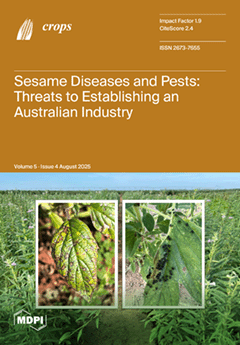Chemical fertilizers pose significant risks to both human health and the environment. To investigate the effect of substituting nitrogen fertilizer with vermicompost tea on wheat yield, shoot chemical constituents, and grain quality under clay-loam soil conditions, two field experiments were conducted at the Faculty of Agriculture, Cairo University, Egypt, during the winter seasons of 2021–2022 and 2022–2023. A split-plot design in randomized complete blocks with three replications was employed. Vermicompost tea was assigned to the main plots, while wheat cultivars were assigned to the subplots. The cultivars were evaluated under four treatments involving partial substitution of mineral nitrogen (recommended dose of nitrogen (RDN%, 190 kg N ha
−1): a control (90% of RDN + 25 kg vermicompost tea), 80% of RDN + 37.5 kg vermicompost tea, and 70% of RDN + 50 kg vermicompost tea. Nitrogen fertilizer (RDN%) was applied at rates of 190 (control), 170 (90%), 150 (80%), and 130 (70%) kg N ha
−1. The results indicated that partially substituting mineral nitrogen with vermicompost tea significantly increased grain weight/Ha, chlorophyll A, chlorophyll B, carotenoids, nitrogen, phosphorus (P), and potassium (K) content in shoots, as well as ash, crude protein, crude fiber, total sugar, and N, P, and K content in wheat grains. The grain weight/Ha of the Sakha-95, Giza-171, and Sads-14 cultivars increased by 38.6%, 33.5%, and 39.3%, respectively, when treated with 70% RDN + 50 kg vermicompost tea. The combination of the Sads-14 cultivar and 70% RDN + 50 kg vermicompost tea resulted in the highest values for grain weight/ha (9.43 tons ha
−1), chlorophyll A (1.39 mg/g), chlorophyll B (1.04 mg/g), N (5.08%), P (1.63%), and P (2.43%) content in shoots. The same combination also improved ash (2.89%), crude fiber (2.84%), and K (6.05%) content in grains. In conclusion, the application of vermicompost tea in conjunction with chemical fertilizers offers a viable alternative to using chemical fertilizers alone, promoting sustainable agricultural practices and improving wheat production. It is recommended that mineral nitrogen fertilizer be partially replaced with vermicompost tea to enhance both the productivity and grain quality of wheat while minimizing environmental pollution.
Full article





